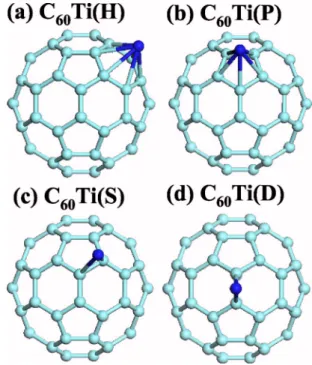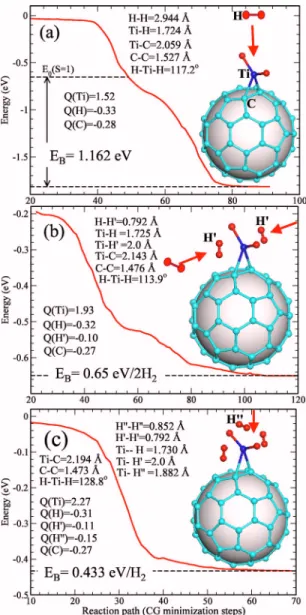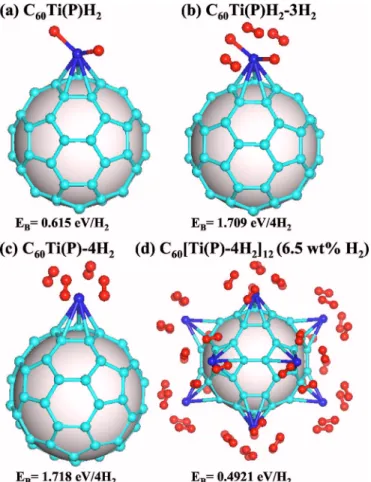Molecular and dissociative adsorption of multiple hydrogen molecules
on transition metal decorated C
60T. Yildirim,1,*Jorge Íñiguez,2and S. Ciraci3
1NIST Center for Neutron Research, National Institute of Standards and Technology, Gaithersburg, Maryland 20899, USA 2Institut de Ciéncia de Materials de Barcelona (CSIC), Campus UAB, 08193 Bellaterra, Barcelona, Spain
3Physics Department, Bilkent University, 06800 Bilkent, Ankara, Turkey
共Received 3 May 2005; revised manuscript received 23 May 2005; published 6 October 2005兲 Recently we have predicted关Phys. Rev. Lett. 94, 175501 共2005兲兴 that Ti-decorated carbon nanotubes can adsorb up to 8-wt. % hydrogen at ambient conditions. Here we show that a similar phenomenon occurs in light transition-metal decorated C60. While Sc and Ti prefer the hexagon共H兲 sites with a binding energy of 2.1 eV,
V and Cr prefer double-bond共D兲 sites with binding energies of 1.3 and 0.8 eV, respectively. Heavier metals such as Mn, Fe, and Co do not bond on C60. Once the metals are adsorbed on C60, each can bind up to four hydrogen molecules with an average binding energy of 0.3– 0.5 eV/ H2. At high metal coverage, we show that
a C60can accommodate six D-site and eight H-site metals, which can adsorb up to 56 H2molecules,
corre-sponding to 7.5 wt. %.
DOI:10.1103/PhysRevB.72.153403 PACS number共s兲: 61.46.⫹w, 68.43.⫺h, 84.60.Ve, 81.07.De An efficient storage media for hydrogen is crucial for the
advancement of hydrogen and fuel-cell technologies.1
Cur-rently, a lot of effort is being devoted to engineering nano-materials so that they dissociate H2molecules into H atoms and reversibly adsorb hydrogen molecules at ambient conditions.1–10Much work has focused on carbon-based
ma-terials such as nanotubes,2–12 and metal hydrides such as
alanates.13It is found that, while the hydrogen-carbon
inter-action is too weak for hydrogen storage at ambient conditions,11 the metal-hydrogen interaction is too strong.
Very recently we have shown14 a way to overcome this
dif-ficulty by forming artificial metal-carbide-like structures on single-wall carbon nanotubes共SWNTs兲. From accurate first-principles calculations, we show that a single Ti atom ad-sorbed on a SWNT can strongly bind up to four hydrogen molecules.14At large Ti coverage we find that a共8,0兲 SWNT
can store hydrogen molecules up to 8 wt. %, exceeding the minimum requirement of 6 wt. % for practical applications. These results can be explained by a simple Dewar-Chatt-Duncanson model,15,16 where the interaction is caused by
donation of charge from the highest occupied orbital of the ligand to the metal empty states and a subsequent back do-nation from filled d orbitals to the lowest unoccupied orbital of the ligand.
Here we show that a similar phenomenon occurs in light transition-metal decorated C60 molecules. We first discuss
several possible adsorption sites for a single Ti atom on a C60 molecule. Then we show how a single Ti atom on a C60
can bind up to four hydrogen molecules via Kubas interaction.15,16Multiple metal coverage cases, yielding up to
8 wt. % hydrogen storage, are discussed next. Finally, we briefly describe the results for other transition metals from Sc to Co.
The first-principles energy calculations were done exactly the same way as dicussed in Ref. 14. We used a cubic super-cell of a = 16 Å for single-metal C60systems and a = 20 Å for full-coverage cases. We also made spin-polarized calcula-tions for cases where the ground state of the metal-coated C60is magnetic.
Figure 1 shows the four possible adsorption sites on a C60 molecule that are considered in this study. The binding ener-gies of a single Ti atom at these sites are given in Table I along with relevant structural parameters. The binding en-ergy is defined as
EB共Ti兲 = E共C60兲 + Espol共Ti兲 − Espol共C60Ti兲, 共1兲
where the Espol energies are obtained from spin-polarized
calculations. Hence, a positive binding energy indicates the system is stable.
Our results indicate that the H site is the most stable con-figuration for C60Ti, with a binding energy of 2.1 eV and Ti
FIG. 1. 共Color online兲 A single Ti atom adsorbed at hexagonal 共H兲 共a兲 and pentagonal 共P兲 共b兲 hollow sites, and single 共S兲 共c兲 and double共D兲 共d兲 bond sites of a C60molecule, respectively.
PHYSICAL REVIEW B 72, 153403共2005兲
magnetic moment S共Ti兲=1 ប. The D site comes next with the shortest Ti-C bonds among the four possible configura-tions. In all cases, we have a charge transfer of about one electron to the C60 molecule. The S site is the least stable
adsorption site and therefore we do not consider it any fur-ther.
Figure 2共a兲 shows the energy variation, obtained from spin-unpolarized calculations, as a single H2 molecule
ap-proaches C60Ti共D兲. The energy first decreases slowly as the
hydrogen approaches the C60Ti共D兲 complex. However, as the
charge overlap gets large, the H2 molecule is attracted
to-wards the Ti atom with a sharp decrease in energy. At this point, the H2 molecule is still intact with a significantly in-creased H-H bond length of 0.9 Å. The second pronounced decrease in energy is associated with the dissociation of the H2 molecule into two H atoms. At this point, the H-H
dis-tance increases up to 2.94 Å. The interaction between H2and
C60Ti共D兲 is always attractive and therefore H2 is adsorbed onto the Ti atom without having to overcome any energy barrier. The final geometry is shown in the inset to Fig. 2共a兲.17 In order to calculate the binding energy for this
dis-sociative adsorption, we computed the total energies of the C60Ti共D兲 and H2reactants and the C60Ti共D兲H2final product 关dashed lines in Fig. 1共a兲兴 from spin-polarized calculations. We obtained a binding energy of 1.16 eV关Fig. 2共a兲兴.
Figure 2共b兲 shows the energy variation as two H2
mol-ecules approach the TiH2 group, one from each side. As in
the single-adsorption case, the energy always decreases, slowly at the beginning and very rapidly at the later stage when the two hydrogen molecules become strongly attached to the C60Ti共D兲H2complex. We denote the final product by
C60Ti共D兲H2-2H2. In the final configuration the two H2
mol-ecules were rotated by 90°, as shown in Fig. 2共b兲. The total energy change upon adsorption is about 0.65 eV 共i.e., 0.325 eV/ H2兲. Unlike in the first adsorption, the second and third H2 molecules do not dissociate, but display a rather
elongated bond of 0.79 Å.
Figure 2共c兲 shows the energy evolution when a fourth hydrogen molecule approaches the C60Ti共D兲H2-2H2 system from the top. The energy again decreases continuously, indi-cating a zero-energy barrier. The final product, denoted by C60Ti共D兲H2-3H2, is shown in the inset. The fourth
adsorp-tion results in an energy gain of 0.433 eV/ H2. The H-H
dis-tance of the top H2is 0.85 Å. Several attempts to add a fifth
hydrogen molecule at a variety of positions failed, suggest-ing a limit of four H2per Ti. However, in view of previous
studies18,19showing that it is possible to attach many H
at-oms to a single transition metal, there might well be other transition paths that could yield more than four hydrogen molecules per C60Ti.
Next we discuss the adsorption properties of a Ti at the H site of the C60, as shown in Fig. 3. For the first H2 adsorp-tion, we find that the molecule does not dissociate, unlike in the case of Ti at a D site关Fig. 2共a兲兴. The reason is that the Ti atom is adsorbed very strongly at the H site and, therefore, there is not enough charge left in the Ti to transfer to the*
orbital of the hydrogen molecule and thus break it.14 The binding energy is about 0.58 eV and the H-H bond length 0.813 Å. Additional H2molecules can be adsorbed, without
any activation-energy barrier, up to four H2 per Ti. The
re-TABLE I. Calculated Ti-C and C-C bond distances, Mulliken charges, spins, and binding energies for a single Ti atom adsorbed at the four different sites of a C60molecule shown in Fig. 1. For bare
C60 the calculated double and single bond lengths are 1.44 and 1.38 Å, respectively. C60Ti共H兲 C60Ti共P兲 C60Ti共D兲 C60Ti共S兲 d共Ti-C兲 共Å兲 2.27 2.33 2.10 2.24 d共C-C兲 共Å兲 1.42/1.45 1.44 1.52 1.48 Q共Ti兲 共e兲 1.39 1.09 0.99 0.84 S共Ti兲 0.99ប 1.40ប 1.13ប 1.54ប EB共Ti兲 共eV兲 2.098 1.633 1.837 1.220
FIG. 2. 共Color online兲 Energy along the reaction paths for dissociative and molecular adsorption of H2 over a single
C60Ti共D兲. 共a兲 H2+ C60Ti共D兲→C60Ti共D兲H2. 共b兲 2H2+ C60Ti共D兲H2
→C60Ti共D兲H2-2H2. 共c兲 H2+ C60Ti共D兲H2-2H2→C60Ti共D兲H2-3H2.
In all the cases, the relevant structural parameters are given. The zero of energy is taken as the sum of the energies of two reactants.
BRIEF REPORTS PHYSICAL REVIEW B 72, 153403共2005兲
sulting system, which is shown in Fig. 3共b兲, is denoted by C60Ti共H兲-4H2. The final configuration is very symmetric,
and all the hydrogen molecules benefit equally from the bonding with the Ti atom. The average binding energy per H2is about 0.465 eV, i.e., slightly smaller than that obtained
for the first adsorption. We have also calculated the binding energy for the isomer C60Ti共H兲H2-3H2, which is about
0.1 eV higher than that of C60Ti共H兲-4H2.
The results for the adsorption of hydrogens at the P-site Ti are summarized in Fig. 4. The first adsorption is found to be dissociative without activation energy. The binding energy is about 0.615 eV, i.e., significantly smaller than that for Ti at the D site关Fig. 2共a兲兴, but the adsorption is still dissociative unlike for Ti at the H site 关Fig. 3共a兲兴. The two isomers, C60Ti共P兲H2-3H2 关Fig. 4共b兲兴 and C60Ti共P兲-4H2 关Fig. 4共c兲兴,
are found to be almost degenerate and yield a binding energy of 0.43 eV/ H2.
Up to this point, we have discussed the interaction of H2 with a single Ti atom bonded to a C60, but clearly one can
imagine attaching additional Ti atoms to a C60, thereby
in-creasing the hydrogen-storage capacity. In order to show the feasibility of this approach, we consider several cases. Figure 4共d兲 shows the full-coverage case where all the P sites of a C60 molecule host a Ti atom, each of which binds four H2
molecules. The calculated binding energy is 0.492 eV/ H2,
which is slightly higher than that of the single-coverage case of Fig. 4共c兲. A possible reason for this is that the C60distorts more in the single-coverage case than in the full-coverage one, which is more symmetric. In fact, we see the same effect in the binding energy of Ti atom at the P site: we get 1.633 eV共see Table I兲 for a single Ti atom and 2.115 eV/Ti when there are Ti atoms at every P site. These results are quite promising, as they suggest that it should be possible to synthesize the fully covered systems. We note that early ex-periments have already indicated that it may be possible to coat C60 共Ref. 20兲 and SWNT 共Ref. 21兲 by light-transition metals.
Figure 5共a兲 shows the case in which six Ti atoms are adsorbed at D sites 共i.e., sites on twofold axes of the C60
molecule兲. As in the case of full Ti共P兲 coverage, the binding energy per H2 共0.592 eV兲 is slightly larger than that of the
single-Ti case共0.559 eV兲. Interestingly, one can further add eight more Ti atoms at the hexagonal faces共i.e., those along the关111兴 directions兲, yielding a total of 14 Ti atoms per C60.
The fully hydrogenated case for this Ti coverage is shown in Fig. 5共b兲. The average binding energy is 0.522 eV/H2, in remarkable agreement with the 0.505 eV/ H2 based on the
energies for single coverage case. This indicates that the 14 Ti atoms and 56 hydrogen molecules shown in Fig. 4共b兲 are not too close to each other, which in turn suggests that the FIG. 3.共Color online兲 Molecular adsorption of a single 共a兲 and
four H2共b兲 on C60Ti共H兲. The binding energies and relevant
struc-tural parameters are given.
FIG. 4. 共Color online兲 Optimized structures of C60with various
coverages of Ti共P兲 and H2. 共a兲 One H2 molecule adsorbed on a
single Ti共P兲. 共b兲, 共c兲 Two isomers with four H2molecules adsorbed on a single Ti共P兲. 共d兲 Full coverage case with twelve Ti共P兲4H2
groups.
FIG. 5. 共Color online兲 Two Ti-coated C60systems with high-density H coverage. They correspond to 4.3 wt. % and 7.5 wt. % H storage if all hydrogens can be released, and to 3.4 wt. % and 6.7 wt. % H storage if only molecularly adsorbed hydrogens can be released.
BRIEF REPORTS PHYSICAL REVIEW B 72, 153403共2005兲
system is able to host many titaniums and hydrogens. In fact, the configuration shown in Fig. 5共b兲, which has the chemical formula C60Ti14H56, stores approximately 7.5 wt. %
hydro-gen.
It is important to know if the results reported above for the C60Ti system hold for other transition metals. Therefore we have also studied the transition metals from Sc to Co. Table II summarizes our results for the binding energies and relevant structural parameters. We find that while Sc and Ti prefer the H site, V and Cr prefer the D site. The binding energies monotonically decrease as we move from left to right of the periodic table. In fact, for Mn, Fe, and Co we obtained negative binding energies, indicating that the C60TM complex is not stable. We also found that the other
transition metals are able to adsorb hydrogen in a way that is similar to that discussed above for Ti. The last line in Table II indicates the average binding energy per H2 in C60TMH2
-3H2 configurations. It increases from 0.3 eV/ H2 for Sc to
0.5 eV/ H2 for V. Then, it decreases to 0.24 eV/ H2 for Cr,
and finally the complex becomes unstable for heavier transi-tion metals.
In conclusion, we have used state-of-the-art first-principles calculations to show that light transition-metal decorated C60 molecules exhibit remarkable hydrogen
stor-age properties. The transition-metal-hydrogen bond is
ex-plained by the Dewar-Chatt-Duncanson model.15,16 The
strength of this interaction 共0.3–0.4 eV兲 and the zero-activation energy for the H2-bonding strongly suggest that
desorption of hydrogen near room temperature is very likely. Our initial molecular dynamics simulations support this con-clusion. These results, along with our previous work on Ti-decorated SWNT,14 suggest a direction towards
high-capacity hydrogen storage materials by decorating nanostructured systems with light transition metals.
We point the reader to an interesting paper 关Phys. Rev. Lett. 94, 155504共2005兲兴, which appeared at about the same time our paper was submitted. In this paper the authors show that transition metals bonded on cyclopentadiene rings 共C5H5兲 are able to absorb many hydrogen molecules. They
propose that the pentagonal faces of C60 could be used to bond transition metals for hydrogen storage. Even though we agree with the main conclusion of this work, we point out that the P sites of C60and the cyclopentadiene rings are not
the same. Our study shows that there is nothing special about P sites and in fact the D and H sites are better for metal absorption. Unlike cyclopentadiene rings, we find that only light transition metals such as Sc, Ti, and V bond on C60共see
Table II兲.
This work was partially supported by DOE under Grant No. DEFC36-04-GO14282.
*Electronic address: taner@nist.gov
1For a review see the special issue Towards a Hydrogen Economy,
R. Coontz and B. Hanson, Science 305, 957共2004兲.
2A. C. Dillon et al., Nature共London兲 386, 377 共1997兲. 3S. P. Chan et al., Phys. Rev. Lett. 87, 205502共2001兲. 4K. Tada et al., Phys. Rev. B 63, 155405共2001兲. 5Y. Miura et al., J. Appl. Phys. 93, 3395共2003兲. 6G. Lu et al., Phys. Rev. B 68, 205416共2003兲.
7P. Dubot and P. Cenedese, Phys. Rev. B 63, 241402共R兲 共2001兲. 8E. C. Lee et al., Phys. Rev. B 66, 073415共2002兲.
9O. Gulseren et al., Phys. Rev. B 66, 121401共R兲 共2002兲. 10O. Gulseren et al., Phys. Rev. Lett. 87, 116802共2001兲.
11S. Dag et al., cond-mat/0504696, Phys. Rev. B共to be published兲. 12W. Q. Deng et al., Phys. Rev. Lett. 92, 166103共2004兲.
13B. Bogdanovic et al., Adv. Mater. 共Weinheim, Ger.兲 15, 1012
共2003兲.
14T. Yildirim and S. Ciraci, Phys. Rev. Lett. 94, 175501共2005兲. 15G. J. Kubas, Metal Dihydrogen and Bond Complexes—Structure,
Theory, and Reactivity 共Kluwer Academic/Plenum, Dordrecht,
2001兲.
16Modern Coordination Chemistry: The Legacy of Joseph Chatt,
edited by G. J. Leigh and N. Winterton共Royal Society of Chem-istry, Cambridge, 2002兲.
17The animations of the reaction paths and optimizations can be
found at http://www.ncnr.nist.gov/staff/taner/h2
18J. Niu et al., Phys. Rev. Lett. 68, 2277共1992兲.
19L. Gagliardi and P. Pyykko, J. Am. Chem. Soc. 126, 15014
共2004兲.
20F. Tast et al., Phys. Rev. Lett. 77, 3529共1996兲.
21Y. Zhang and H. Dai, Appl. Phys. Lett. 77, 3015 共2000兲; Y.
Zhang et al., Chem. Phys. Lett. 331, 35共2000兲. TABLE II. Calculated TM-C and C-C bond distances, Mulliken charges, spins and binding energies for a single TM atom共TM=Sc,Ti,V, etc.兲 adsorbed on a C60molecule.
Properties C60Sc共H兲 C60Ti共H兲 C60V共D兲 C60Cr共D兲 C60Mn共D兲 C60Fe共D兲 C60Co共D兲 d共TM-C兲 共Å兲 2.29 2.27 2.18 2.09 2.30 2.28 2.26 d共C-C兲 共Å兲 1.42/1.46 1.42/ 1.45 1.46 1.50 1.45 1.45 1.45 Q共TM兲 共e兲 1.55 1.39 0.78 0.91 0.97 0.86 0.76 S共TM兲 0.24ប 0.99ប 2.0ប 2.35ប 2.99ប 2.53ប 1.54ប EB共TM兲 共eV兲 2.127 2.098 1.308 0.760 −0.017 −0.130 −0.503 EB共H2兲 共eV兲 0.300 0.454 0.497 0.239 −0.092
BRIEF REPORTS PHYSICAL REVIEW B 72, 153403共2005兲



